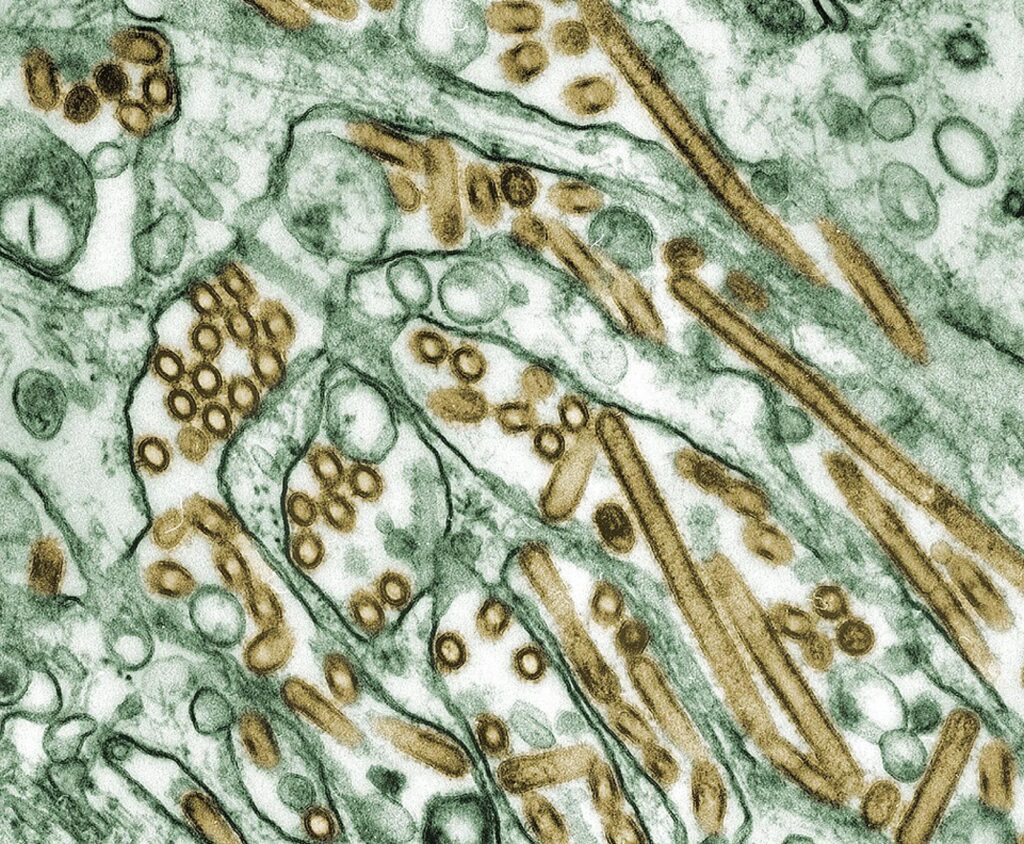Colorized transmission electron micrograph of Avian influenza A H5N1 viruses (seen in gold) grown in MDCK cells (seen in green).
Photo Credit: Cynthia Goldsmith Content Providers: CDC/ Courtesy of Cynthia Goldsmith; Jacqueline Katz; Sherif R. Zaki

The Centers for Disease Control and Prevention (CDC) reported there is a reduced susceptibility for influenza antiviral, oseltamivir (Tamiflu) against 2 mutations, I223V + S247N, of the avian influenza A(H1N1) pdm09 viruses. The viruses, which are circulating through 5 continents, belong to 2 phylogenetically distinct groups and display ≈13-fold reduced inhibition by oseltamivir while retaining normal susceptibility to other antivirals, according to a report in the latest issue of CDC’s Emerging Infectious Diseases journal.1
“Three classes of direct-acting antivirals targeting the influenza virus matrix protein 2 (M2) ion channel, neuraminidase (NA), or polymerase cap-dependent endonuclease (CEN) are approved to treat influenza in many countries, the CDC authors write. “Although most seasonal influenza viruses are susceptible to NA and CEN inhibitors, emergence of antiviral-resistant variants is a public health concern because of widespread resistance to M2 inhibitors and possibilities of similar resistance developing for other antiviral drugs.”1
The World Health Organization (WHO) says it is monitoring oseltamivir susceptibility through their Global Influenza Surveillance and Response System (WHO-GISRS).
The CDC authors wrote NA amino acid substitution H275Y, acquired spontaneously or after drug exposure, confers resistance to oseltamivir. “Oseltamivir-resistant influenza A(H1N1) viruses with H275Y emerged first in Europe during 2007–2008 and rapidly spread worldwide. However, they were displaced by influenza A(H1N1)pdm09 (pH1N1), the swine-origin virus that caused the 2009 pandemic,” they point out.
“Although there are no established criteria for determining clinically relevant oseltamivir resistance based on phenotypic testing, for surveillance purposes, influenza A viruses tested in NA inhibition assays are classified as displaying reduced inhibition if they have a 50% inhibitory concentration (IC50) 10-100–fold higher or as highly reduced inhibition if IC50 >100-fold higher than that of a reference,” they also write.
Learn more: Deconstructing the Avian Flu
Study Parameters and Results
From May 2023 to February 2024, the investigators examined 2039 pH1N1 viruses from both the United States (n = 1274) and 38 other countries (n = 765). Of these, 4 of them had the H275Y substitution, indicating low frequency of oseltamivir resistance. Analysis revealed NA substitution I223V in 18 and S247N in 15 viruses; those substitutions confer mildly elevated oseltamivir IC50 (<10-fold) according to the investigators. They also discovered 17 viruses that carried both substitutions, I223V + S247N. The CDC authors note that Hong Kong investigators also saw the emergence of the dual mutants.
“As expected, single mutants exhibited normal inhibition by oseltamivir and other NA inhibitors in NA inhibition assay,” the investigators wrote. “The 6 viruses with I223V + S247N displayed 13- to 16-fold reduced inhibition for oseltamivir and normal inhibition (<4-fold) for other NA inhibitors.”
Incidence Numbers
Right now, there has not been a large caseload of people infected; however, there has been a slightly over 50%mortality rate in these patients. According to the WHO, from 2003 to April 1, 2024, a total of 889 cases and 463 deaths (CFR 52%) caused by influenza A(H5N1) virus have been reported from 23 countries. The most recently reported case in humans prior to the current case, was in March 2024 in Vietnam.2 On May 15, the Michigan Department of Health and Human Services (MDHHS) announced a new case of avian influenza was reported in a Michigan farmworker, which makes it the second case in the state and third overall in the US.3 All cases thus far has been in farmworkers who have had contact with cows.
Although this form of influenza initially was found in birds, several herds of cows have been infected with H5N1.
Takeaways
Although there was reduced susceptibility of oseltamivir in the dual mutants, the investigators look at other antivirals.
“The dual mutants that we tested retained susceptibility to other approved influenza antiviral drugs, including baloxavir,” the CDC authors wrote.
Sequencing data showed the dual mutants have been in global circulation since May of last but that the detection of it was low (0.67%, 101/15,003).
They do point out that they may have been limited to true incidence rates due to differences in surveillance and sequencing strategies performed in various countries. However, those data may not necessarily represent the actual proportion of what was in circulation because of differences in surveillance and sequencing strategies in each country.








